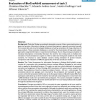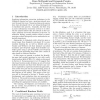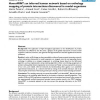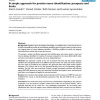BMCBI
2005
13 years 11 months ago
2005
Background: Molecular Biology accumulated substantial amounts of data concerning functions of genes and proteins. Information relating to functional descriptions is generally extr...
BMCBI
2005
13 years 11 months ago
2005
Background: The BioCreative text mining evaluation investigated the application of text mining methods to the task of automatically extracting information from text in biomedical ...
BMCBI
2005
13 years 11 months ago
2005
BMCBI
2005
13 years 11 months ago
2005
Background: The SH3 domain family is one of the most representative and widely studied cases of so-called Peptide Recognition Modules (PRM). The polyproline II motif PxxP that gen...
BMCBI
2005
13 years 11 months ago
2005
Background: Our goal in BioCreAtIve has been to assess the state of the art in text mining, with emphasis on applications that reflect real biological applications, e.g., the cura...
BMCBI
2005
13 years 11 months ago
2005
Background: Our approach to Task 1A was inspired by Tanabe and Wilbur's ABGene system [1,2]. Like Tanabe and Wilbur, we approached the problem as one of part-of-speech taggin...
BMCBI
2005
2005
MicroGen: a MIAME compliant web system for microarray experiment information and workflow management
13 years 11 months ago
Background: Improvements of bio-nano-technologies and biomolecular techniques have led to increasing production of high-throughput experimental data. Spotted cDNA microarray is on...
BMCBI
2005
13 years 11 months ago
2005
Background: The application of high throughput approaches to the identification of protein interactions has offered for the first time a glimpse of the global interactome of some ...
BMCBI
2005
13 years 11 months ago
2005
Background: Significant parts of biological knowledge are available only as unstructured text in articles of biomedical journals. By automatically identifying gene and gene produc...
BMCBI
2005
13 years 11 months ago
2005
Background: Protein-protein, protein-DNA and protein-RNA interactions are of central importance in biological systems. Quadrapole Time-of-flight (Q-TOF) mass spectrometry is a sen...




